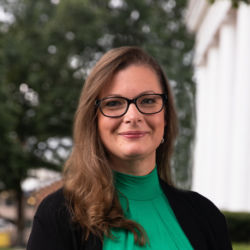Centre College’s President Milton C. Moreland: Navigating Economic Diversity, Philanthropy, and Student Success
December 19, 2023

Reading Time: 6 minutes
The students who go to this college are going to lift themselves, they're going to propel [themselves] further and have more opportunities. As presidents, we should double down on the message of the value of college, particularly for families that need that boost and are outside of the range where they think they can afford a world-class education.
Centre College's student body represents true socioeconomic diversity. Today, the Kentucky college enrolls and graduates similar percentages of students from all income levels, including the "missing middle" of middle-class students who don't qualify for federal aid but need help paying for college. In 2023, ATI recognized Centre as a high-flier for achieving one of the five highest Pell share increases in the membership. At Centre, 21 percent of students are Pell-eligible, and 21 percent are first-generation.
Centre President Milton C. Moreland says economic diversity makes for a richer experience for students, especially on a residential campus. "These folks live together, eat together, work together, think together, walk the sidewalks together," Moreland says. "It's a meaningful experience."
To maintain this level of diversity, Centre must be creative with its fundraising and financial aid packaging. Here, Moreland shares with ATI the messages that resonate with donors, conservative or liberal, and with middle-class families who don't think they can afford a private college. He also talks about what Centre is doing to raise retention and graduation rates so that every student who enters the college leaves with a valuable degree.
###
Tenure in the Presidency: 3 years Accelerating Opportunity Goal: 20+ or Maintain Pell Share
Q: What role does philanthropy play in Centre's economic diversity?
Philanthropy is a big part of it. This is an expensive model. If you've got 60% of your students in the middle, those students are going to need some aid. And some of them are going to need a lot of aid. We pay [particular] attention to students just above Pell. We'd love to have them here, and we're going to have to package them with financial aid that gets them in the door.
There's a lot of students that have come through colleges like Centre who were middle class and would like to help other folks who don't see an avenue to pay for this first-rate education. I'm knocking on their doors a lot. I talk to alumni about what they experienced at the college, and what they valued. Often, they don't know the college has had economic diversity for a long time. When they hear about it, it makes sense to them, thinking about their experiences and friend groups. As we become more diverse in all ways, holding onto that economic diversity is a powerful message for those alumni.
That message also resonates regionally. We think about Kentucky and being able to meet the middle class [here] with financial aid packaging and a strong return on investment. It has also helped with local foundations, to say we are meeting the needs of people in our communities. We're making a world-class education available to folks who typically don't think they can afford it.
Q: You're in a conservative state. How do you talk to potential donors who might be skeptical of higher education? Do you have any advice for other presidents?
A: We're all keenly aware of the devaluation [of higher education] crisis that we're facing. We continue to push out the value proposition, but with good data [behind it]. On our website, and in the presentations that I make to potential donors, I state matter of fact: the return on investment is great. I love that because wherever you're coming from on the political spectrum, one thing many of our donors have in common is they want to see a strong economy. They've got different ideas about how to do that, but when the rubber hits the road with higher education, the message is clear. The students who go to this college are going to lift themselves, they're going to propel [themselves] further and have more opportunities. As presidents, we should double down on the message of the value of college, particularly for families that need that boost and are outside of the range where they think they can afford a world-class education.
Q: As a small college with more limited resources, what choices did you have to make to prioritize economic diversity?
We are focusing on retention, not only recruiting these students and getting them in the door, but keeping them here. Budget-wise it sounds like more money, but in fact those funds are paying the bottom line back because of our increased retention rate and graduation rate. We set a goal to increase the graduation rate by 5 percent over the coming five years. It's a promise to our students that when you come here, we really want to see you walk across the stage with a job, with a great career or an acceptance to a first-rate graduate program.
An example [of our retention efforts] would be what we're calling the Thrive grant. Every lower income, first gen student gets $5,000 in wraparound funds. Again, philanthropy is making that happen.
[We know lower-income students] could drop out of school because of a $500 issue, say with their family, and they've got to go to work. We want them to be able to stay in school. If you've got $5,000 as a student, that keeps you moving forward. It also gives you the same opportunities as anybody else at the college, for study abroad or buying books or a computer.
Q: What do you see as the next big challenge for Centre?
We think a lot about all the little cracks where people fall. That's why we have our big initiatives with student success coaching. We are really trying to target where some of the student needs are, and then provide funding to level the playing field for all students.
[One of the benefits of a small college is] we know everybody. But now, we've got to layer that with great data and think about some of the ways in which students thrive here and the ways in which some drop off the radar. It's been interesting in the last year to think about data usage as a great way not just to get folks here, and how to make a terrific and diverse class, but also how to keep them moving forward. And that's part of what this student success coaching model is about. We have a new vice president of student success. Four new student success coaches are embedded in Academic Affairs, the Centre Learning Commons, athletics, and our first-gen office.
We know from both Academic Affairs and Health and Counseling staff that student concerns tend to follow the natural "due dates" of the term--the four-week mark, midterms, and exam times.
We provide specific outreach at the 4-week and 8-week points of the semester. After four weeks, faculty are asked to submit early progress reports to let advisors and others know who may be "at risk" in their courses. This includes students who are not attending regularly, not completing assignments, or struggling with course content. After eight weeks, midterm reports are issued for students who have a D or a U at the halfway point of the term. These are two times that Academic Affairs and advisors reach out to students via email and in-person conversations to try and assist them in getting the support they need.
Students also need support during transition times in their college careers. For instance, in October, first-year students have often made their first B, had transitions in their friendship groups back home, or become homesick. Other difficult transitions include when a student leaves an athletic team through choice or injury, goes through the major declaration process, or returns from study away and must navigate changes in their old friendship group. We turned our main floor of the library into the Learning Commons. Students can go there when they need help or want to help other students. We turned this area into a real working space where we can meet students and say, it's normal to struggle at certain moments. You're in the majority here. Let's work through it.
Every college is going to be a little bit different, but for colleges like Centre, the retention piece is almost equal with the recruitment piece, in terms of how to move the college forward [with ATI goals]. We've really leveled that up.


